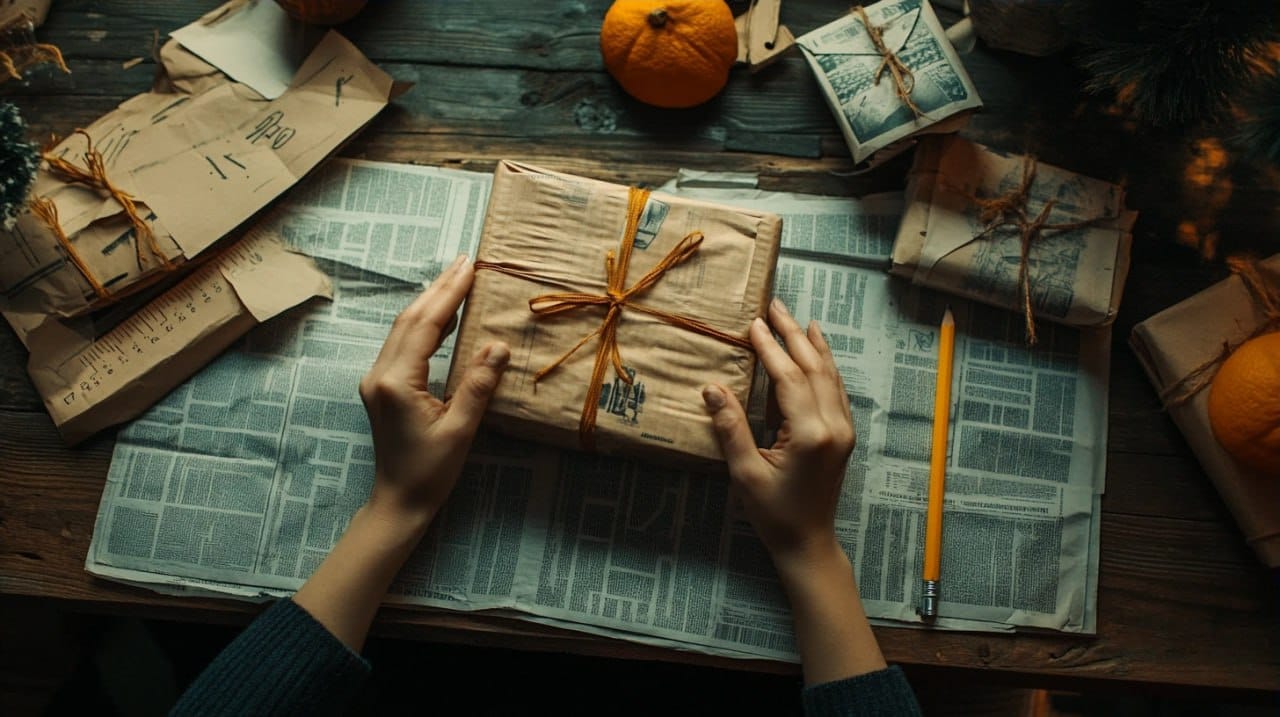How to have an eco-friendly Christmas: Your ultimate guide
Christmas is a magical time, but people’s waste during holidays negatively impacts our planet. In this article, we explain how to enjoy the festivities and indulge your loved ones while maintaining a sustainable approach to Christmas gifts, décor, and food.

The festive season approaches and you are probably busy choosing gifts, buying home décor to impress your guests, and planning the menu for a holiday meal. But here’s a question: is there a way to celebrate while minimizing the environmental impact? Below, you’ll find pointers to organize an eco-friendly Christmas and take care of the planet.
Prepare sustainable gifts
Buying eco-friendly, sustainable gifts this year is a great way to minimize waste and show that you care for your loved ones and the planet. Consider making DIY items, buy local to minimize carbon footprint, or give recyclable, zero-waste gifts. Suggest exchanging eco-friendly items with the family, coworkers, and friends to minimize the impact.
Strategies for sustainable gift-giving
- Buy smarter. Many people get Christmas presents they don’t want. Such presents collect dust on shelves until they get tossed. To avoid this, take the time to learn the person’s preferences and give something they will use.
- Buy from sustainable brands. Consider brands with a transparent process of manufacturing and supply chain. Opt for items from renewable materials.
- Shop local. Buying from local brands reduces your carbon footprint and supports your community. Plus, you can find unique items from local artisans that your friends or family will be excited to have.
- Give an experience. You don’t have to give a physical present. Consider a gift card to a large retailer or an experience gift (such as animal encounters, movie or concert tickets, or a spa day). Opt for a digital gift certificate, if possible.
- Prepare a DIY present. Giving a good DIY item will show that you truly care for the person and are willing to put in the extra effort. Mind the recipient’s preferences: if your friend or coworker has a healthy diet, no need to give handmade chocolate cookies.
5 DIY recyclable gift ideas
- Sugar body scrub – combine brown sugar with coconut or olive oil. Add essential oil (cinnamon, lemon, or orange) and transfer into a clean jar.
- Handmade bath salt – mix 2 cups of Epsom salt with 1 cup of sea salt and ½ cups of baking soda. Add a few drops of any essential oil and dried flowers or herbs (optional).
- Jar candles – empty glass jars you have at home. Melt wax in a boiler, add essential oils. Glue wick to the bottom of the jar and then slowly pour melted wax into the jar. Let it cool until the wax hardens.
- Cracker candy – you need saltine crackers, 1 cup butter, 1 cup brown sugar and nuts of M&M’s for topping. Line a baking sheet with foil and arrange saltine crackers in a single layer. In a saucepan, melt butter and brown sugar over medium heat. Bake at 350°F (175°C) for 5 minutes, then remove from oven, sprinkle with chocolate chips and add optional toppings. Let cool.
- Play dough – this dough is a fun activity for kids and an anti-stress ritual for adults. Mix 1 cup of flour, ½ cup of salt, 2 teaspoons of cream, 1 cup of water, and 1 tablespoon vegetable oil in a saucepan. Cook over medium heat and stir until the mixture forms a ball and pulls away from the sides of the pan. Put on a floured surface until smooth. Store in an airtight container.
Organize an eco-friendly Secret Santa exchange
Secret Santa is a beloved holiday tradition, so why not organize a sustainable gift exchange this year? You can prepare a meaningful eco-friendly gift for one assigned person. Here’s how it works:
- Draw names from the hat (or use our MySanta app) to decide who gives a present to whom.
- Set the gift theme, for example, self-care items, something for the home, creative gifts, or anything sustainable. Set the budget for gifts (for example, $20) or exchange homemade items.
- Each participant secretly prepares a gift for the assigned person. If you use the MySanta app, you can create wishlists and chat secretly with your giftee to know their preferences.
- On the gift exchange day, everyone brings a wrapped gift to the party. People unwraps their presents and guess the giftee, which always leads to laughter and fun!
You can do an eco-friendly Secret Santa online and exchange virtual gifts. Read below how to organize a remote game.

Making eco-friendly gift wrapping
Most people use traditional wrapping paper that isn’t eco-friendly as it’s made with non-recyclable materials and ends up in landfills. For a more sustainable approach to gift-giving, use kraft paper because it’s recyclable and biodegradable. Add dried flowers, leaves, or orange slices for stylish, eco-friendly packaging. Here are some more creative and economical ideas for wrapping your gifts:
- Avoid tape and plastic ribbons. Use an eco-friendly jute ribbon instead.
- Wrap gifts using materials found at home. For example, old newspapers, magazines, calendars, or maps can be used as creative packaging and cost nothing.
- Reuse materials. Wrap presents using old clothes or boxes to make your packaging creative, save money, and minimize environmental impact.
- Use the Furoshiki wrapping. This is a Japanese wrapping technique using square pieces of fabric to wrap the present of any size. Read more in this step-by-step guide.
- Don’t use wrapping. Hand in your gift in a bag or without any wrapping – after all, if your present is great, packaging is not so important.
Decorating the place

Your home décor can be eco-friendly, too. Try creating a Christmas ambiance at home by upcycling decorations, using sustainable items, or making decorations at home. Here are some ideas for your inspiration:
- Use LED lights in your house and Christmas tree. They consume less energy and are more sustainable.
- If you plan to buy decorations, opt for ethical, eco-friendly items. Consider natural renewable materials, such as fabric ribbons, wooden decorations for a Christmas tree and tables, and cloth napkins.
- Upcycle old clothes and toys, creating unique custom decorations that set the mood.
- If you have an artificial Christmas tree, keep using it as long as possible. Thus, you’ll minimize the carbon footprint. If you don’t, opt for a real tree – this option is greener as Christmas trees are compostable. Or, consider renting a tree in a pot if such services are offered in your area.
- Make DIY home décor. Handmade decorations are great for your budget and the environment.
6 handmade Christmas décor ideas
1. Dried orange slices for ornaments, or gift decoration. Add cinnamon sticks or cloves for fragrance.
2. Painted pinecones can be turned into rustic garlands.
3. Cinnamon stick bundles – tie them with ribbon to create a Christmas tree or table décor.
4. Cardboard ornaments – cut out various shapes, and decorate with paint or markers.
5. Paper chains – turn magazine pages or old paper into garlands.
6. Natural wreaths – use evergreen branches, pine cones, and berries to create unique wreaths.
Sustainable approach to Christmas food
During Christmas time, families produce enormous food waste. To minimize the environmental impact of holiday meals, try this:
- Plan ahead. Calculate how much food and drinks you will need based on the number of guests coming over. Thus, you’ll avoid cooking too much and then throwing it away.
Tip: Use this Christmas portion planner to calculate how much of each ingredient you’ll need for a festive dinner.
- Add more plants to your Christmas dinners. Of course, many families cannot imagine the celebration without the traditional turkey. However, you can focus on preparing more plant-based sides and salads or try alternative meat to minimize greenhouse gas emissions.
- Look for certifications. When buying products in supermarkets, choose certified food made with sustainable ingredients. Look for certifications like RSPO Roundtable on Sustainable Palm Oil or ASC Aquaculture Stewardship Council.
- Shop seasonal produce. Buy seasonal fruit and vegetables to reduce carbon footprint. Plus, it’s a great inspiration to cook something new this year!
- Store the leftovers. Use plastic containers or aluminum foil to keep food fresh for days.
Christmas holidays contribute to excessive landfill and pollution, but you can reduce your impact. By planning your meal ahead, giving sustainable presents, and making DIY décor, you’ll significantly cut down the environmental impact and save money on the festivities.
FAQs
What are some eco-friendly gift ideas?
Give an experience gift (such as concert tickets, cooking classes, or spa day), gifts made by local artisans, secondhand items, or homemade presents. Another great idea is to give a present that promotes sustainability (such as a reusable water bottle, festive cloth napkins, organic shampoo, or a solar-powered gadget).
What should I do with my Christmas tree after the holidays?
Check if your local municipality offers tree recycling programs (chipping or mulching). You can also use the branches as mulch in your garden or create a wildlife habitat.
How do I minimize the environmental impact of Christmas travel?
Consider carpooling or taking public transportation instead of traveling by plane. Alternatively, offset your carbon emissions by donating to an environmental organization. If your friends or extended family live far away, consider a virtual celebration.


